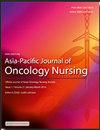Disparities in cancer-related financial toxicity across economically diverse provinces in China: A multi-center cross-sectional study
IF 2.8
3区 医学
Q1 NURSING
引用次数: 0
Abstract
Objective
China’s diverse economic landscape across its regions may contribute to disparities in cancer-related financial toxicity (FT), but empirical evidence is lacking. This study examined regional disparities in cancer-related FT across economically diverse provinces in China.
Methods
A cross-sectional study was conducted among adult patients with cancer from six tertiary and six secondary hospitals across three Chinese provinces with varying economic statuses (high-, middle-, and low-income). FT was assessed using the COmprehensive Score for financial Toxicity (COST). Hierarchical regression analysis was employed to compare FT among participants from different economic regions, controlling for 13 patient-level sociodemographic and clinical risk factors.
Results
From February to October 2022, 1208 participants completed the survey (response rate = 97.3%). Mean COST scores were 21.99 ± 6.37 (high-income), 20.38 ± 8.01 (middle-income), and 19.20 ± 5.14 (low-income), showing significant differences (P < 0.001), with lower scores indicating more severe FT. After adjusting for covariates, regional economic level was significantly associated with FT, with more severe FT in middle- (B: −1.515; 95% CI: −2.250, −0.780) and low-income regions (B: −2.159; 95% CI: −2.899, −1.418) than in high-income regions.
Conclusions
This study reveals significant disparities in cancer-related FT across economically diverse provinces in China. The findings underscore the need for targeted policies and interventions to improve health equity in cancer care, with a focus on not neglecting middle-income regions. Oncology nurses are expected to enhance awareness of FT management, voice the needs of patients, and advocate for policy reforms to address these disparities.

中国不同经济省份癌症相关金融毒性差异:一项多中心横断面研究
目的:中国各地区不同的经济格局可能导致癌症相关金融毒性(FT)的差异,但缺乏经验证据。本研究考察了中国不同经济省份癌症相关金融服务的地区差异。方法:对来自中国三个省份不同经济状况(高、中、低收入)的六所三级医院和六所二级医院的成年癌症患者进行横断面研究。FT采用金融毒性综合评分(COST)进行评估。在控制13个患者层面的社会人口学和临床危险因素的情况下,采用层次回归分析比较不同经济区域参与者的FT。结果:2022年2月至10月,共1208人完成调查,回复率为97.3%。平均COST得分分别为21.99±6.37(高收入)、20.38±8.01(中等收入)和19.20±5.14(低收入),存在显著差异(P)。结论:本研究揭示了中国不同经济省份癌症相关FT的显著差异。研究结果强调需要有针对性的政策和干预措施,以改善癌症治疗中的卫生公平性,重点是不要忽视中等收入地区。肿瘤科护士应提高对FT管理的认识,表达患者的需求,并倡导政策改革以解决这些差异。
本文章由计算机程序翻译,如有差异,请以英文原文为准。
求助全文
约1分钟内获得全文
求助全文
来源期刊

Asia-Pacific Journal of Oncology Nursing
Multiple-
CiteScore
2.80
自引率
11.10%
发文量
136
审稿时长
31 days
 求助内容:
求助内容: 应助结果提醒方式:
应助结果提醒方式:


